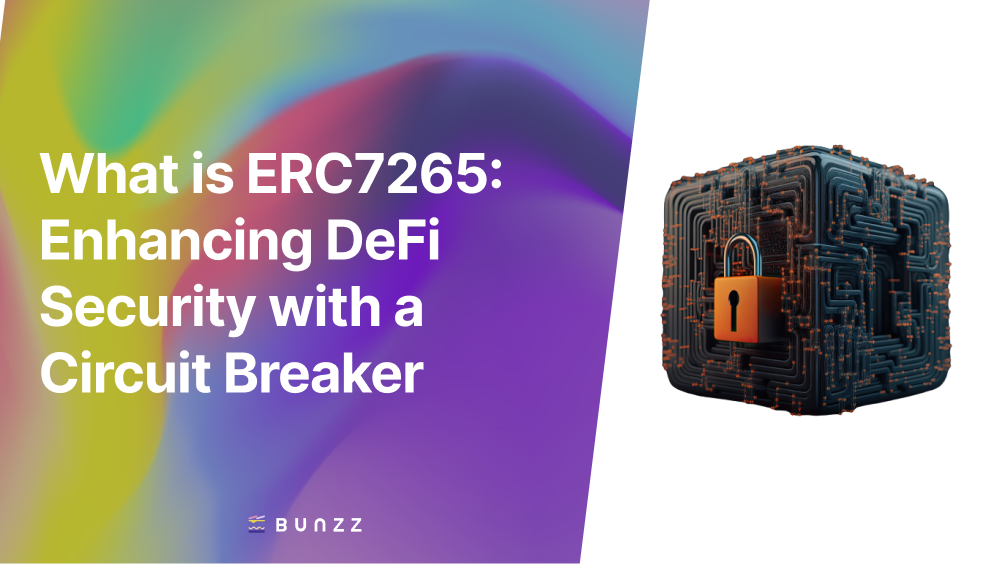The decentralized finance (DeFi) space has experienced a surge in security breaches, posing significant risks to user funds and protocol integrity. To address this growing concern, members of the Ethereum community have proposed a new standard known as ERC 7265. This standard aims to bolster DeFi security by introducing a “circuit breaker” mechanism into smart contracts, which can effectively mitigate the impact of hacks and other security threats.
Brace yourself, as we discover how this standard, ERC 7265, could drastically change the landscape of DeFi security, promising to deliver a safer platform for users and maintain the robustness of this new-age financial system. As we unfold the workings, potential impact and future ERC 7265 holds, you’ll understand this groundbreaking proposal comprehensively. Buckle up as we dive into this captivating security journey in the DeFi world.
Why was ERC7265 developed? What can be solved?
The motivation behind ERC 7265 stems from the alarming vulnerabilities exposed by recent high-profile security breaches in various DeFi protocols. Incidents involving platforms such as Poly Network, Chibi Finance, and Sturdy Finance have highlighted the need for robust protective measures in the DeFi sector. The primary objective of ERC 7265 is to provide protocols with a fail-safe mechanism that can halt token transactions before they exit contracts during a hack.
These hacks have demonstrated the critical vulnerability of DeFi protocols once compromised, resulting in rapid and irreparable damage. Total value locked (TVL) often plummets to zero within seconds, leaving users with substantial losses. ERC 7265 offers a potential solution by extending the response time available to protocols, enabling them to address security breaches before significant funds are drained.
Features of ERC7265: Implementing the Circuit Breaker
At its core, ERC 7265 proposes the integration of a “circuit breaker” feature into DeFi protocols. This circuit breaker acts as a protective mechanism within smart contracts, providing a temporary halt on token outflows when a predefined threshold for a specific metric is exceeded. Developers have the flexibility to determine whether the circuit breaker should delay settlement and temporarily custody outflows during a cooldown period or revert attempted outflows altogether.
The introduction of the circuit breaker adds an additional layer of security and control to DeFi protocols. By stopping token transactions during a hack, it significantly limits the ability of attackers to drain an entire contract within seconds. According to Meir Bank of Fluid Protocol, the majority of funds can be recovered by implementing this mechanism, mitigating the devastating impact of security breaches.
ERC 7265 Use-cases for DeFi Projects
The proposed standard, ERC 7265, has garnered significant attention within the decentralized finance (DeFi) community due to its potential to bolster security measures. DeFi projects, recognizing the urgent need for enhanced protection against hacks and exploits, have been exploring the use case of ERC 7265 to safeguard their protocols. Here are some key usecases showcasing how DeFi projects can benefit from this proposed standard:
- Mitigating Losses: ERC 7265 introduces a circuit breaker mechanism that enables protocols to temporarily halt token outflows during a hack or security breach. By preventing immediate and complete drainage of funds, the majority of losses can be mitigated. DeFi projects can significantly benefit from this feature, as it offers a crucial response time to address security incidents and protect user funds.
- Customizable Parameters: The proposed standard allows DeFi projects to customize rate limit parameters per asset, providing flexibility and tailored security measures. This customization empowers project teams to design circuit breakers specific to their protocols’ requirements, further enhancing their security infrastructure.
- Compatibility with Upgradeable Projects: ERC 7265 is designed for DeFi protocols that can be upgraded by governance. As governance-driven upgrades are common in the DeFi ecosystem, this proposed standard seamlessly integrates with such projects. DeFi platforms that embrace this standard can easily implement the circuit breaker mechanism and reap its security benefits.
- Trust Restoration: Recent high-profile hacks have shaken trust within the DeFi community. Implementing ERC 7265 can help restore confidence by showcasing a proactive commitment to security and user protection. DeFi projects that adopt this proposed standard demonstrate their dedication to addressing vulnerabilities and prioritizing the security of their users’ funds.
- Community-Driven Improvement: The development and implementation of ERC 7265 exemplify the collaborative nature of the DeFi community. By proposing and discussing standards like ERC 7265, stakeholders collectively work toward enhancing the security of the entire ecosystem. This community-driven approach fosters innovation and ensures that DeFi protocols continue to evolve with robust security measures.
Benefits of ERC 7265
Enhanced Security
Including a circuit breaker mechanism can significantly bolster the security of DeFi protocols. This mechanism acts as a safeguard during abnormal market conditions or when specific metrics indicate potential risks. By temporarily pausing token outflows when predetermined thresholds are exceeded, the circuit breaker helps protect users’ funds and ensures overall protocol stability.
Reduced Risk
The circuit breaker mechanism introduces an additional layer of risk reduction by allowing developers to delay settlement or reverse attempted outflows. This adaptability enables protocols to swiftly address unforeseen risks or issues, minimizing potential losses and enhancing the risk profile of DeFi platforms. Fail-safe procedures like these contribute to a more secure ecosystem.
Promoted Protocol Stability
During periods of market volatility or the emergence of anomalies, the circuit breaker mechanism plays a vital role in maintaining protocol stability. By temporarily halting token outflows, protocols can identify and address potential problems, reducing the likelihood of catastrophic failures. This consistency and reliability inspire confidence among users and attract more participants to DeFi platforms.
Flexibility for Developers
The circuit breaker contract offers developers the flexibility to customize the mechanism according to their specific requirements. This customization is particularly valuable for protocols with diverse use cases, risk profiles, or tokenomic designs. Developers can select the option that aligns best with their protocol’s needs, enabling them to optimize stability and control.
User Safeguarding
The circuit breaker mechanism serves as a crucial safety feature for users by mitigating potential losses. It assists in limiting the exposure of funds during severe circumstances such as smart contract vulnerabilities or unexpected market downturns. By reducing risks, the circuit breaker inspires trust among users, leading to increased adoption of DeFi platforms and a stronger user base.
While ERC 7265 is still in the proposal stage and requires approval from the Ethereum community, its potential impact on DeFi security is already gaining attention. As DeFi projects continue to face evolving security threats, the adoption of this proposed standard can provide a much-needed layer of protection and foster a safer environment for users and investors.
In conclusion, DeFi, like any other innovation, has hiccups. Yet, initiatives like ERC 7265 ensure its continuous growth and maturation. The Ethereum community’s relentless pursuit of better security measures promises to make the DeFi space even more robust and resilient. The road ahead is certainly interesting, and the anticipation for what ERC 7265 can bring to this space is high. DeFi’s future looks secure, and we can’t wait to see how it unfolds.







